If you need to produce extremely fast pulses in response to an input and trigger, such as for sampling applications, the predictably programmable short-time-interval generator has broad uses. The circuit of Figure 1, built around a quad high-speed comparator and a high-speed gate, has settable 0- to 10 ns output width with 520 ps, 5 V transitions. Pulse width varies less than 100 ps with 5 V supply variations of 65%. The minimum input-trigger width is 30 ns, and input-output delay is 18 ns.
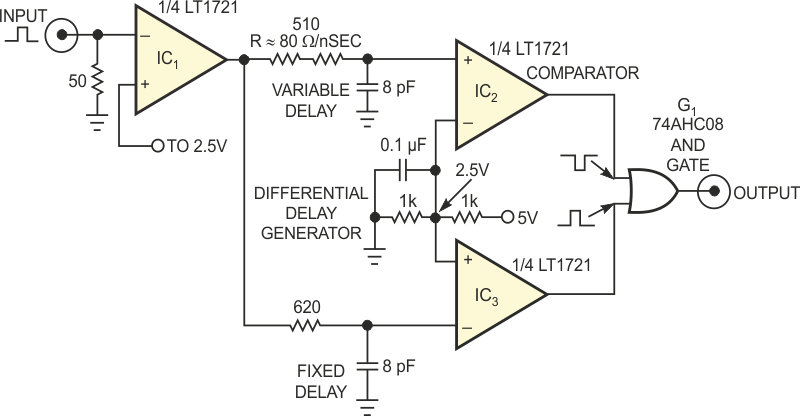 |
||
| Figure 1. | This pulse generator has 0- to 10-nsec width and 520-psec transitions. IC1 unloads termination and drives the differential delay network. The IC2-IC3 complementary outputs represent delay difference as edge timing skew. G1, which is high during IC2-IC3’s positive overlap, presents circuit output. |
|
Comparator IC1 inverts the input pulse (Figure 2, Trace A) and isolates the 50 Ω termination. IC1's output drives fixed and variable RC networks. Programming resistor RG primarily determines the networks' charge-time difference and, hence, delay at a scale factor of approx 80 Ω/ns. Comparators IC2 and IC3, arranged as complementary-output-level detectors, represent the networks' delay difference as edge-timing skew. Trace B is IC3's fixed-path output, and Trace C is IC2's variable output. Gate G1's output (Trace D), which is high during IC2-IC3 positive overlap, presents the circuit output pulse.
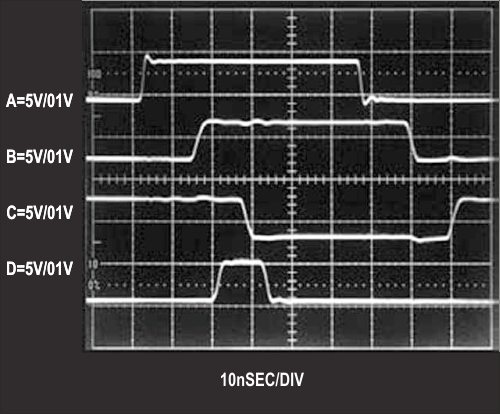 |
||
| Figure 2. | Pulse-generator waveforms, viewed in 400-MHz real-time bandwidth, include input (Trace A), IC3 (Trace B) fixed and IC2 (Trace C) variable outputs and output pulse (Trace D). RC networks differential delay manifests as IC2-IC3 positive overlap. G1 extracts this interval and presents circuit output. |
|
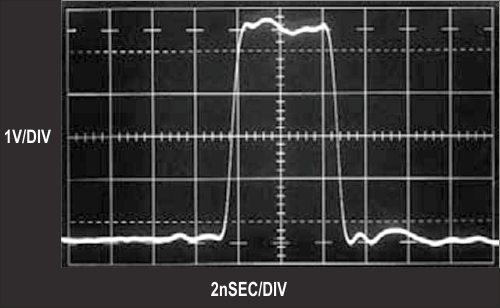 |
||
| Figure 3. | The 5-nsec-wide output with R = 390 W is clean with well-defined transitions. Post-transition aberrations are within 8% and derive from G1 bond-wire inductance and an imperfect coaxial probe path. |
|
Figure 3 shows a 5 V, 5 ns width, measured at 50% amplitude, output pulse with R = 390 Ω. The pulse is clean and has well-defined transitions. Post-transition aberrations, within 8%, derive from G1's bond-wire inductance and an imperfect coaxial probing path. Figure 4 shows the narrowest full amplitude, 5 V pulse available. Width measures 1 ns at the 50% amplitude point and 1.7 ns at the base in a 3.9 GHz bandwidth. Shorter widths are available if partial amplitude pulses are acceptable.
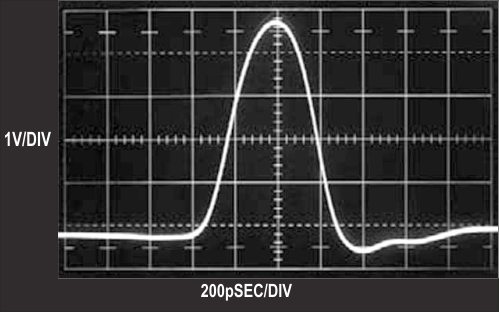 |
||
| Figure 4. | The narrowest amplitude pulse width is 1 nsec, and the base width measures 1.7 nsec. Measurement bandwidth is 3.9 GHz. |
|
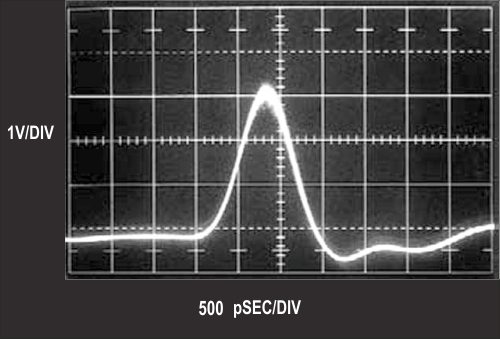 |
||
| Figure 5. | The partial-amplitude pulse, 3.3 V high, measures 700 psec wide with a 1.25-nsec base. The trace granularity is an artifact of the 3.9-GHz sampling- oscilloscope operation. |
|
G1's rise time limits minimum achievable pulse width. The partial-amplitude pulse, 3.3 V high, measures 700 ps with a 1.25 ns base (Figure 5). Figure 6, taken in a 3.9 GHz sampled bandpass, measures 520 ps rise time. Fall time is similar. The transition of the probe edge is well-defined and free of artifacts.
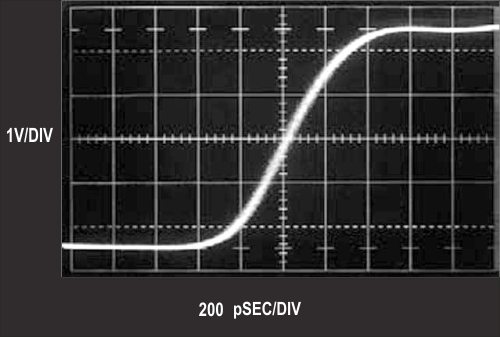 |
||
| Figure 6. | A transition detail in the 3.9-GHz bandpass with rise time of 90 psec shows 520-psec rise time; fall time is similar. The granularity derives from sampling-oscilloscope operation. |
|
